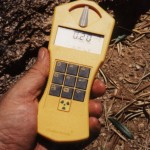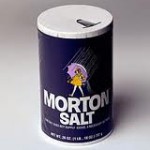The recent scare with nuclear fall out has many pharmacies out of iodine tablets. Given the thousands of miles between the US and Japan, there is no need to take supplemental iodine. In fact, excess iodine can have deleterious effects on a person.
If there were a nuclear disaster with radiation in your area the officials would typically recommend taking one tablet – a single dose. At the most it may be one tablet for a few days- but on the basis of what the public health officials say. Repeat dosing, especially to pregnant or breastfeeding individuals can be harmful.

Geiger Counter
Radioactive iodine loses half its radioactivity in a week. As the radioactive iodine enters the weather patterns there will be detectable radioactivity from Japan, however it will be in amounts so small that they will be less than the amount of radiation you would get sunning yourself on a typical day.
Taking excess iodine can lead to thyroid goiter (where your thyroid gland enlarges and becomes filled with nodules). It can cause diarrhea, nausea, and vomiting. The recommended daily does of iodine for men is 150 micrograms, and 120 micrograms for women (or 150 mcg if they are pregnant and 200 mcg if nursing). For children the dose is between 70 and 150 micrograms.

Iodine is needed by the thyroid gland to make thyroid hormone. Iodine that is consumed is quickly brought to the thyroid gland (which is why Geiger counters are used at the neck area to see if there is evidence of radioactivity).
Typical foods that contain iodine are seafood – a 7-ounce fillet contains all the iodine a person needs). Most seafood has about 66 mcg of iodine (about half the daily requirement) for 3.5 ounces. Vegetables contain about 75 mcg of iodine per cup. Meat contains about 26 mcg of iodine per quarter pound, and one egg contains 13 -26 mcg of iodine. Iodized salt is the best source of iodine – 1 teaspoon about 400 mcg.
In terms of the iodine tablets the CDC recommends:
“The FDA has approved two different forms of KI—tablets and liquid—that people can take by mouth after a nuclear radiation emergency. Tablets come in two strengths, 130 milligram (mg) and 65 mg. The tablets are scored so they may be cut into smaller pieces for lower doses. Each milliliter (mL) of the oral liquid solution contains 65 mg of KI.
According to the FDA, the following doses are appropriate to take after internal contamination with (or likely internal contamination with) radioactive iodine:
* Adults should take 130 mg (one 130 mg tablet OR two 65 mg tablets OR two mL of solution).
* Women who are breastfeeding should take the adult dose of 130 mg.
* Children between 3 and 18 years of age should take 65 mg (one 65 mg tablet OR 1 mL of solution). Children who are adult size (greater than or equal to 150 pounds) should take the full adult dose, regardless of their age.
* Infants and children between 1 month and 3 years of age should take 32 mg (½ of a 65 mg tablet OR ½ mL of solution). This dose is for both nursing and non-nursing infants and children.
* Newborns from birth to 1 month of age should be given 16 mg (¼ of a 65 mg tablet or ¼ mL of solution). This dose is for both nursing and non-nursing newborn infants.”
As much as there is talk about radioactive iodine- it is not a risk in the United States. There is no need to take supplemental iodine. In fact, supplemental iodine can put infants, pregnant mothers, and breastfeeding moms at high risk.
DO NOT TAKE iodine, unless the public health officials state it is needed. Until then, know the iodine rich foods- and make certain your diet has plenty.
